Door into Bomb Shelter at Auschwitz
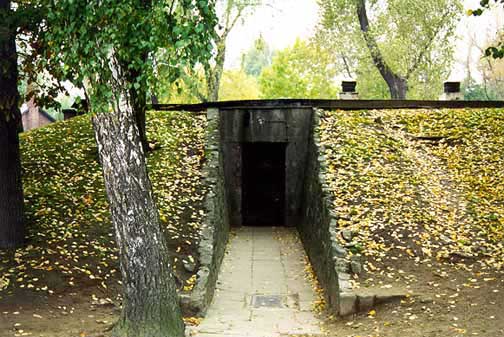 Door into bomb shelter,
Sept. 1998
Door into bomb shelter,
Sept. 1998
The photograph above shows one of the
entrances into the reconstructed Krema I gas chamber at the Auschwitz
main camp. This door was added by the Nazis in the fall of 1944
when the gas chamber was converted into an air raid shelter.
When I visited Auschwitz in 2005, this door was locked and the
tourist entrance was through the original door on the other side
of the building, which is shown in the photo below.
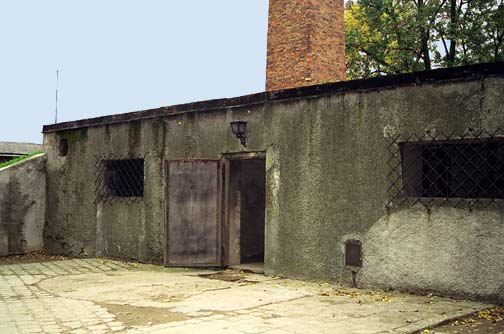 Original entrance into
the crematorium in the main Auschwitz camp, Sept. 1998
Original entrance into
the crematorium in the main Auschwitz camp, Sept. 1998
The photo below shows the air raid shelter
door, taken from the interior of the gas chamber in 2005. This
is a metal door, which has a peephole, but the glass in the peephole
is gone now. The peephole was for people on the inside to look
out; anyone looking through this peephole from the outside would
only be able to see the back wall of the tiny vestibule.
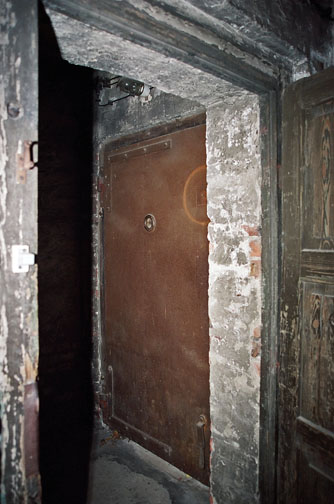 Air raid shelter door
that was added in 1944, Oct. 2005
Air raid shelter door
that was added in 1944, Oct. 2005
Inside the vestibule, a door on the left
opens into the gas chamber, as you can see in the 2005 photo
below. The black line on the wall is exposed electrical wiring.
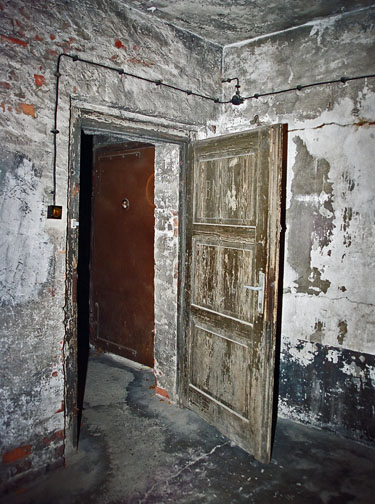 Door into bomb shelter,
Oct. 2005
Door into bomb shelter,
Oct. 2005
Robert Jan van Pelt & Deborah Dwork
wrote in their book "Auschwitz 1270 to the Present,"
that the routine gassing of humans was inaugurated at Auschwitz
I on September 16, 1941 when 900 Soviet Prisoners of War were
killed in the mortuary room of the crematorium which had just
been converted into a gas chamber. Shortly before that, the mortuary
room had been put into service as an execution chamber where
Polish political prisoners were shot because the Black
Wall, formerly used for executions, proved to be too far
away from the crematorium for an efficient system.
Commandant Rudolf Höss described
the 1941 gassing of the Soviet Prisoners of War in the following
quote from his memoirs:
I have a clearer recollection of the
gassing of 900 Russians that took place shortly afterwards in
the old crematorium, since the use of block 11 for this purpose
caused too much trouble. While the transport was detraining,
holes were pierced in the earth and concrete ceiling of the mortuary.
The Russians were ordered to undress in an anteroom; they then
quietly entered the mortuary, for they had been told they were
to be deloused. The whole transport exactly filled the mortuary
to capacity. The doors were then sealed and the gas shaken down
through the holes in the roof. I do not know how long this killing
took. For a little while a humming sound could be heard. When
the powder was thrown in, there were cries of "Gas!"
then a great bellowing, and the trapped prisoners hurled themselves
against both doors. But the doors held. They were opened several
hours later so that the place might be aired.
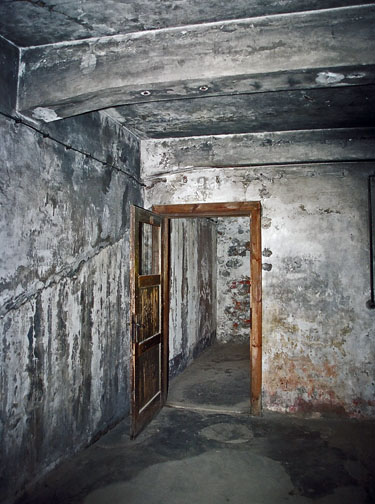 The door into the washroom
that is now included in the gas chamber, Oct. 2005
The door into the washroom
that is now included in the gas chamber, Oct. 2005
When Höss wrote "both doors,"
he was referring to the door from the wash room into the gas
chamber and the door from the gas chamber into the oven room.
The photo above shows the door from the "laying out"
(autopsy) room into the washroom, which is shown in the foreground.
The reconstructed gas chamber includes the former washroom and
the door from the washroom into the gas chamber is no longer
in existence. Some visitors today mistakenly think that the door
shown in the photo above was the door into the gas chamber, but
it is actually the door into the former wash room.
The vestibule shown in the photos at
the top of this page, through which tourists entered in 1998,
was not there until September 1944 when the gas chamber was converted
into an air raid shelter. The victims entered the gas chamber
by going through the "laying out" room and then through
the washroom, according to the Auschwitz Museum. The reconstructed
gas chamber that tourists see today includes the former wash
room.
Note that Höss describes the roof
of the gas chamber as being covered with "earth and concrete."
Today, the gas chamber building has a flat roof with no earth
covering it.
The two anterooms that the victims had
to enter before going into the gas chamber were the "laying
out room" and the washroom, which were not large enough
for 900 men to undress.
The description of the "old crematorium"
given by Commandant Rudolf Höss, as quoted above, seems
to fit the gas chamber in the "mortuary" of Krema II at Birkenau, which had an anteroom
where the prisoners undressed. Other witnesses described the
roof of the gas chamber in the mortuary of Krema II as being
covered by earth and concrete.
Höss described the gas as a "powder,"
but today visitors are told that the gas was in the form of pellets
that were the size of peas.
This page was last updated on June 3,
2009
|